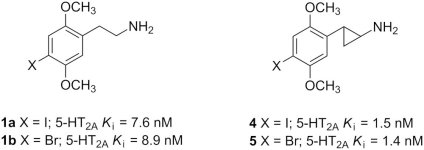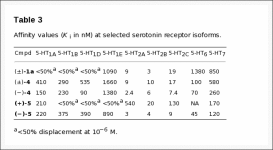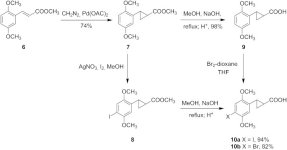entheogenic-gnosis
Rising Star
Summary
A strategy to replace the ethylamine side chain of 2,5-dimethoxy-4-iodoamphetamine (DOI, 1a), and 2,5-dimethoxy-4-bromoamphetamine (DOB, 1b) with a cyclopropylamine moiety was successful in leading to compounds with high affinity at the 5-HT2 family of receptors; and the more potent stereoisomer of the cyclopropane analogues had the expected (−)-(1R,2S)-configuration. Screening for affinity at various serotonin receptor subtypes, however, revealed that the cyclopropane congeners also had increased affinity at several sites in addition to the 5-HT2A and 5-HT2B receptors. Therefore, at appropriate doses – although (−)-4 and (−)-5 may be useful as tools to probe 5-HT2 receptor function – one would need to be mindful that their selectivity for 5-HT2A receptors is somewhat less than for DOI itself.

trans-2-(2,5-Dimethoxy-4-iodophenyl)cyclopropylamine and trans-2-(2,5-dimethoxy-4-bromophenyl)cyclopropylamine as potent agonists for the 5-HT2 receptor family
A strategy to replace the ethylamine side chain of 2,5-dimethoxy-4-iodoamphetamine (DOI, 1a), and 2,5-dimethoxy-4-bromoamphetamine (DOB, 1b) with a cyclopropylamine moiety was successful in leading to compounds with high affinity at the 5-HT[2] family ...www.ncbi.nlm.nih.gov
-eg





